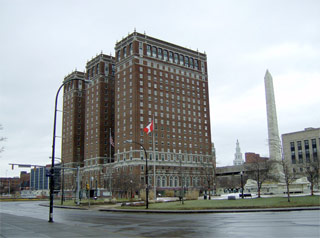UB Law School at The Statler: Silver Bullet or Golden Ticket?
by John McMahon

Last week Congressman Brian Higgins called on University at Buffalo President John Simpson and his colleagues to consider moving UB’s law school into the now vacant Statler Building, a historic landmark in the heart of downtown Buffalo.
“UB Law School, the only law school in the SUNY system, should be located in the urban core. [It would] bring youthful energy and vitality to the urban core as well as an opportunity for their students to live, work and learn where all of the action takes place,” a Buffalo News article quoted Higgins as saying.
The Simpson administration was quick to reject the plan. “Moving the law school to downtown Buffalo would isolate it and strand it away from the university’s other graduate programs and resources, which would not be in the best interests of our students. Moreover, managing scattered and isolated buildings is not good for UB, nor is it good stewardship of the state’s resources,” UB spokesman John DellaContrada told the News.
Meanwhile, the New York Times published a sobering story about the travails young lawyers are facing in the current environment, entitled “No longer their golden ticket.” In essence, the article points out that the reality is in stark contrast to the adventures played out by young lawyers on TV: “As the profession lurches through its worst slump in decades, with jobs and bonuses cut and internal pressures to perform rising, associates do not just feel as if they are diving into the deep end, but rather, drowning.”
Obviously, some types of practices are being hit much harder than others. But as this new debate over the future of Buffalo’s law school played out in the pages of the Buffalo News, the Times article presented another twist. Daniel Lukasik runs a Web site called “Lawyers with Depression” (www.lawyerswithdepression.com). Commenting on the growing sense of despair in his profession, he said that he “recently received a call from a man who said he was a fifth-year associate in Manhattan who complained that he felt expendable even though he was a top performer.
“He said to me, ‘What more do I have to do?’” Mr. Lukasik recalled. ‘I’m billing a large amount of hours, I’m a team player,’ but he said it’s very possible he might lose his job. And he was a Yale graduate, at a top-20 firm.”
Coincidentally, Lukasik practices law here in Buffalo with the firm Cantor, Lukasik, Dolce, Panepinto. He created the site because he too suffers from depression. Depression in the legal community, of course, is nothing new. Just think of Paul Newman in The Verdict. However, in trying to bring the law school into downtown to fill the vacant Statler building, we should acknowledge that at least some UB Law School graduates will face far more difficult decisions than which end of the subway line they will live on.
Psychologists agree that persons who suffer from depression need support in combating their illness. But the work environments at many law firms seems to be more like Survivor than LA Law. It’s increasingly more about numbers than people. Of course, as the corporate counsel brass ring recedes from view, society’s need for court-appointed attorneys and those willing to work pro bono to challenge secret government and corporate avarice continues to grow.
In Buffalo, economic development has always been about buildings, not people. From the renovation of the Sidway building to the Buffalo Niagara Partnership’s new digs, the construction or renovation of buildings seems to take precedence over real job creation for the residents of Buffalo. While government investment undoubtedly helps the building trades and the developers of these projects, it begs the much greater question that economic planners should be asking themselves: For whom does an economy exist?
What has happened to Buffalo’s downtown economy over time says a lot about the direction the US has gone since the Reagan revolution. The consequences of the conscious decision to eliminate the nation’s industrial base are important because what we were left with here was an urban center that had become a bureaucratic matrix administering to poverty, while still serving various entertainment functions.
The corporate headquarters of M&T Bank and Blue Cross and Blue Shield are the last big fish in the pond; government workers, the courts system, and the poor are the City of Buffalo’s lifeblood. As the city lost its economic diversity, it grew much weaker. The so-called knowledge economy—with banking, insurance, real estate speculation, and, of course, law—doesn’t look like a very smart choice at the moment.
Would UB Law School downtown help? It might, but the underlying economic questions remain. Just last fall UB President John Simpson said that state budget problems could still put the entire UB 2020 master plan in jeopardy. Is the state’s budget crisis solved or will it become another permanent fixture on Buffalo’s horizon? In planning for the future, perhaps we should concentrate less on silver bullets or golden tickets and focus more on simply trying to care for each other as best we can.
John McMahon is a freelance journalist.
blog comments powered by Disqus|
Issue Navigation> Issue Index > v9n3 (week of Thursday, January 21) > UB Law School at The Statler: Silver Bullet or Golden Ticket? This Week's Issue • Artvoice Daily • Artvoice TV • Events Calendar • Classifieds |









 Current Issue
Current Issue